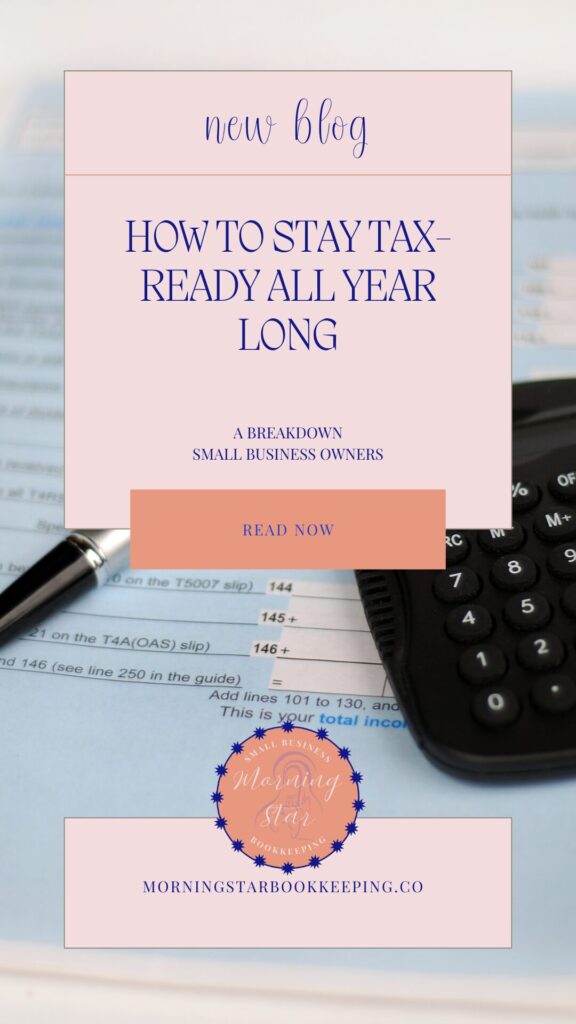Staying tax-ready as a small business owner can feel overwhelming, but with the right approach and tools, it can be a much more manageable part of your business operations. By staying organized and consistent, you can not only reduce the stress of tax season but also ensure you’re maximizing your deductions and keeping your business on solid financial ground. Below, we’ll cover key steps to keep your business tax-ready throughout the year and how software like Xero, QuickBooks, and Sage can support you along the way.

Keeping Accurate Records
Accurate and consistent record-keeping is the foundation of tax readiness.
Maintaining proper financial records ensures that when tax season comes around, you can confidently report your income and expenses. Without this, you risk missing deductions, paying more than you owe, or facing audits.
So what the hell should I be tracking?
- Income and Expenses: Record every source of income and every business expense, no matter how small. If it came into your account, record it. If it left, record it and upload a receipt.
- Receipts and Invoices: Store all business-related receipts and invoices digitally, so they’re easily accessible. If you have them saved to a cloud, they will always be there, easily accessible. After your taxes are file and done, you can zip and lock the files so nothing can be changed.
- Mileage and Travel: If you use your personal vehicle for business, keep track of your mileage and travel expenses. Keep a log of all your business and personal miles. Keep a log of every penny spent on maintenance – this will help you decide if you should be taking mileage or expensing the work done on a car.
Who can I use to stay organized?
- Xero & Sage are my first choices for software, followed by Quickbooks and Zoho. You can upload receipts and enter them as you go. You can also automate these so the entries are there and you can just double check them.
- A file in Google Drive. Seriously, it can be that easy. Have a file with the month on it and upload the receipts as you get them. Enter them at the end of the week
- Send the paperwork to your bookkeeper. If she is like me, you will have a portal with all your stuff in it, plus a vault and file with all your documentation in triplicate.
Separating Personal and Business Finances
One common mistake, and my biggest pet peeve, small business owners make is mixing personal and business finances. This can create confusion and lead to incorrect reporting come tax season. Set up a separate bank account for your business to keep things clear and to make it easier to identify business-related transactions.
Want to take it a step further ? Open three accounts:
- A business account for your accounts payable – you only pay from here (this can be a credit card rather than an account).
- An account for your receivables. You need to be paid into an account, make a business checking for that.
- A tax savings account. 30% of your income should be going right into this account. Pay all your taxes directly from here.
- BONUS: You can open a savings account for your business as well, or you can funnel that money into your tax account and just pull out what is left to invest after paying taxes.
Estimating Your Tax Liability
As a small business owner, it’s crucial to set aside money throughout the year for taxes. A good rule of thumb is to allocate 30% of your income for taxes, but your actual tax liability will depend on your business structure and profit margins. Failing to do this could leave you scrambling to come up with the funds when taxes are due. Your bookkeeping software should be doing the heavy lifting here and keeping you up to date on what you potentially owe, but it is always good to have a general idea of what you need to pay each quarter. You have three general options for how to handle taxes:
- Use your prior year tax returns to get an idea of what you need to pay. This works really well for companies that don’t usually vary from year to year with income.
- Estimate and pay quarterly. Figure out what you owe for all income made from now back to the beginning of the year – subtract what you have already paid and pay the rest each quarter.
- Pay at the end of the year. This one isn’t without risk though. You could end up paying fees and fines. You have to gauge if it is worth it.
Know Your Deductions
Small businesses are entitled to many deductions that reduce taxable income, from home office deductions to the cost of equipment and supplies. Make sure you’re aware of what deductions apply to your business so you don’t leave any money on the table.
Common deductions include:
- Business-related travel and mileage
- Office supplies and equipment
- Utilities and rent (for office spaces)
- Marketing and advertising expenses
- Professional services (bookkeeping, legal fees, etc.)
Working with a Professional
Even with the best software, tax laws can be complex and ever-changing. Having a professional bookkeeper or accountant review your records ensures accuracy and can save you money by identifying deductions or credits you might not know about. Plus, they can help you implement the best software and processes to keep your business tax-ready year-round.

If you still need help with your books, don’t hesitate to book a call. I provide a complete solution to keep your books in order and ensure you’re always tax-ready. From setting up your software correctly to catching up on past records, I help small businesses stay compliant and maximize their tax savings.
